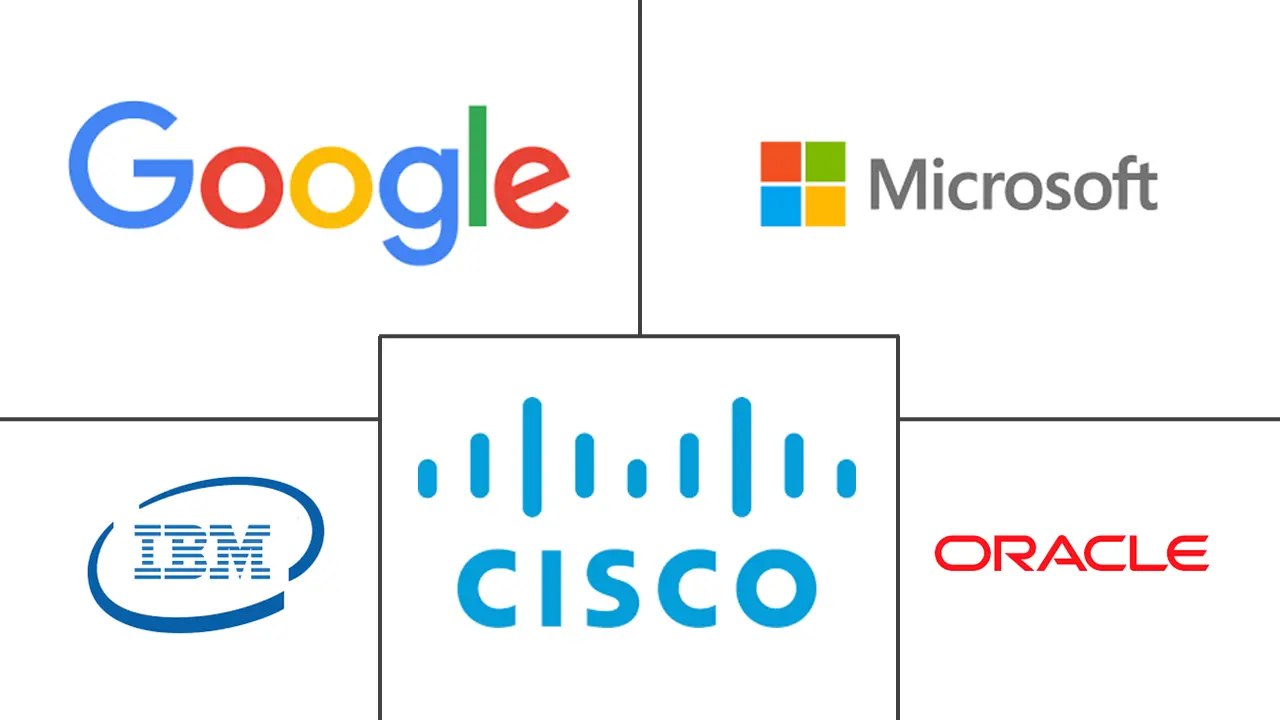Mexico Digital Transformation Market Size and Share
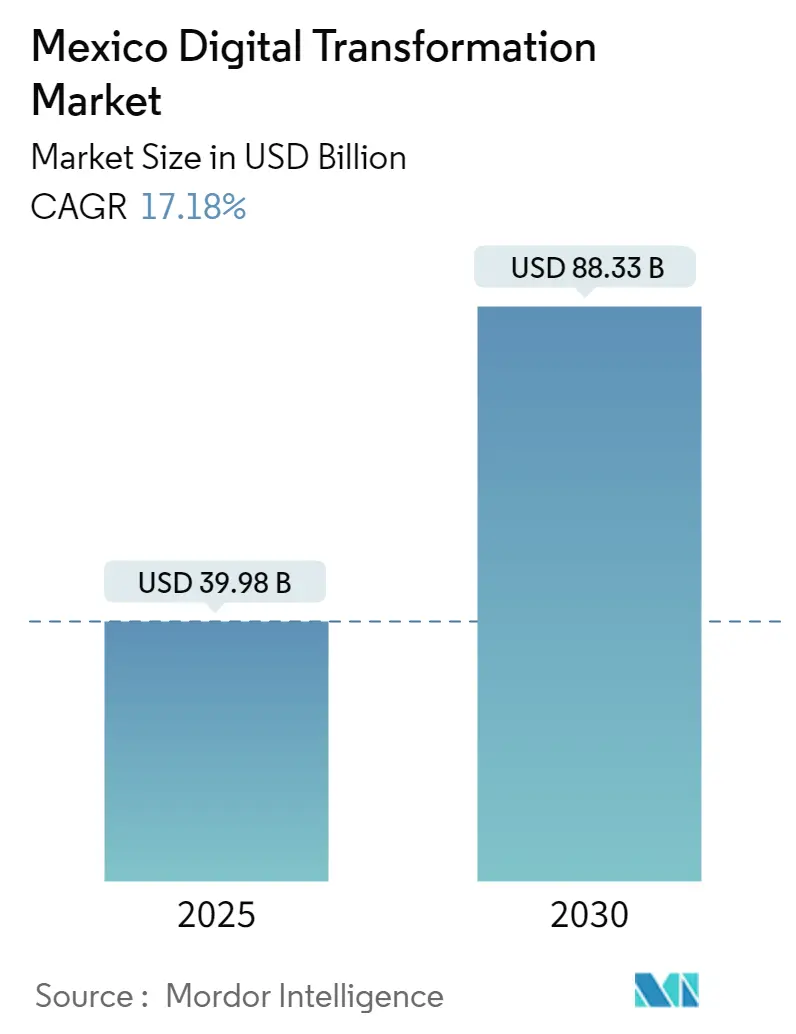
Mexico Digital Transformation Market Analysis by Mordor Intelligence
The Mexico Digital Transformation Market size is estimated at USD 39.98 billion in 2025, and is expected to reach USD 88.33 billion by 2030, at a CAGR of 17.18% during the forecast period (2025-2030).
- Mexico has implemented several digital transformation policies to modernize its government and promote the development of digital technologies. These policies include a whole-of-government approach, sound governance frameworks, and a national digital strategy. Additionally, Mexico has a digital economic policy agenda, which promotes policies and interventions to foster digital development. The country's leading development plan, the 2019-24 national development plan, also emphasizes the importance of national strategies and international cooperation for digital transformation. The Mexican government has established the Digital Transformation Center Mexico and has partnered with institutions like Google Cloud to accelerate its digital transformation measures.
- Further, Mexican society's reliance on information and communications technology (ICTs) and online government services has surged. The financial sector and the broader economy rely heavily on digital platforms. Yet, this interconnectivity also exposes the nation to risks, underscoring the critical need for a robust national security strategy. Mexico's National Cybersecurity Strategy, charting a course to 2030, is designed to equip the nation for the challenges of an increasingly digital landscape. Its overarching goal is to position Mexico as a resilient player in cyberspace, offering a broad, enduring framework for future endeavors.
- Moreover, The mouse revolutionized computer inputs, transitioning from the keyboard's linear to a two-dimensional realm. Building on this, gesture-based computing marks a leap, introducing three-dimensional inputs that immerse users in the computing experience. These interfaces foster a more intuitive learning approach, often resembling play, and hold significant promise, especially when paired with extended reality (XR). Within the market, advancements have given rise to the 'Kai gesture controller'—a wearable device that tracks hand movements, enabling users to control games and apps through gestures. Furthermore, it seamlessly pairs with devices via Bluetooth.
- Further, Mexico has been increasing its adoption of cloud computing in recent years, with the government at all levels playing an essential role. In particular, several initiatives are underway to improve the use of cloud services in the public sector. For example, the Mexican government has been working closely with cloud service providers like Oracle to strengthen the government services that they offer to the public. Customers in Mexico will have access to a wide range of network partners through the Oracle Cloud Querétaro region, allowing for a private and direct connection via OCI FastConnect.
- On the contrary, Artificial Intelligence (AI) is a pivotal opportunity within the life sciences industry, promising transformative potential. In the upcoming years, AI is set to be a focal point for investments, drawing a diverse range of organizations eager to harness its capabilities. As the applications of AI multiply, early investor interest is on the rise. Yet, despite its allure, investing in AI at the nascent stage can be challenging, potentially stunting a company's growth. Launching robust AI products demands substantial financial backing, and monetizing these ventures takes a lot of work. Moreover, developing such products often necessitates specialized teams in machine learning, adding to the financial outlay.
Mexico Digital Transformation Market Trends and Insights
Cloud and Edge Computing is Expected to Hold Significant Share
- The market is poised for growth, driven by escalating demands for cost-effective solutions, a surge in digital business strategies, a growing appetite for the Internet of Things (IoT), and an increasing ease and speed of cloud service deployment. The global cloud services market is further bolstered by the expanding base of internet users, leading to a surge in data generation. However, securely managing this deluge of data poses a significant challenge.
- Despite this, many companies rely on traditional data centers to store client and corporate data. Yet, providers are expected to roll out more cost-effective cloud-based data centers as more businesses pivot to cloud computing. Fueled by a plethora of cloud service providers, the resulting competitive pricing will be a boon for enterprises, enabling them to store data more efficiently and compactly.
- Public cloud services, offered by providers, cater to a broad online consumer base, delivering SaaS, IaaS, and PaaS solutions. The standout feature of public clouds lies in their ability to facilitate resource sharing on a large scale, empowering firms to enhance their employee capabilities.
- The global market is witnessing a surge in IaaS benefits, further fueling its expansion. Major players like Microsoft are swiftly transitioning their offerings, such as Dynamics 365, Office 365, and Windows as a Service, to cloud-centric models. While IaaS development is a key driver, the collective efforts of global giants like Google, Microsoft, Oracle, and IBM are propelling the cloud's growth worldwide.
- The growing adoption of the BYOD trend and other mobility solutions is set to propel the use of cloud communication platforms. BYOD, a cornerstone of modern workplace flexibility, not only enhances network accessibility but also boosts productivity. Cisco reports that companies embracing BYOD save an average of USD 350 per employee annually. With proactive measures, these savings can escalate to USD 1,300 per employee. For Small to Medium Businesses (SMBs), these savings are pivotal, safeguarding their bottom line and enhancing productivity.
- The cloud players in the market are expanding their presence in the region to cater various needs of the customer. For instance, in September 2023, In a strategic move, Oracle, in collaboration with Teléfonos de México, unveiled its second Oracle Cloud Region in Mexico. This milestone cements Oracle's position as a hyperscaler and underscores its commitment to bolstering accessibility and resilience in the Mexican market. TELMEX-Triara, as the hosting partner for the newly established Oracle Cloud Monterrey Region, emerges as a trailblazer, being among the first telcos in Mexico to extend Oracle Cloud Infrastructure (OCI) services to local organizations.
- By leveraging the dual cloud regions within Mexico, Oracle and TELMEX-Triara aim to empower businesses, ensuring robust business continuity. Moreover, this move directly addresses Mexico's stringent data residency and sovereignty mandates, offering enhanced redundancy and disaster recovery capabilities.
- According to International Institute for Management Development 2023, Mexico obtained an overall score of 51.26 out of 100, ranking. Companies are constructing a more robust infrastructure in response to increased demand, and there is greater adoption of new technologies and solutions, which is further supporting market growth. As industries face heightened competition, they are ramping up technology investments to secure a competitive edge. The market is poised for robust demand in the coming years, fueled by the convergence of AI, machine learning, and the swift adoption of IoT and connected infrastructure alongside hybrid cloud solutions.
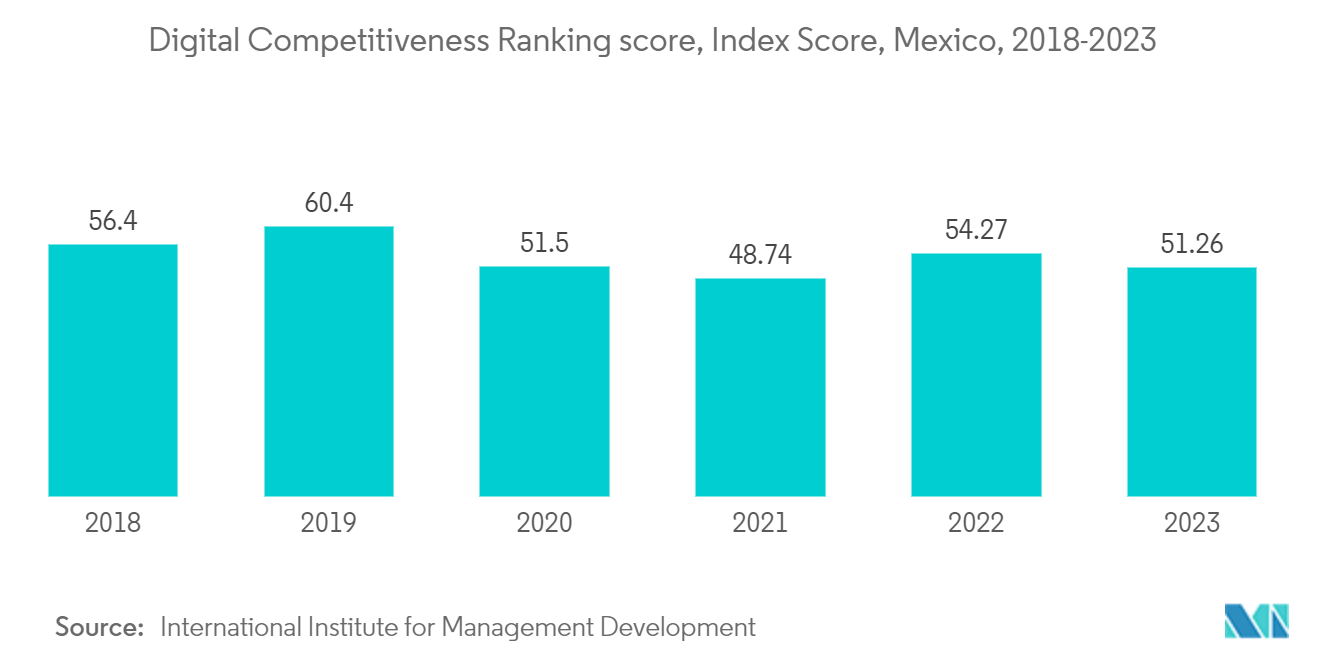
BFSI Segment is Expected to Hold Significant Share of the Market
- Digital transformation has had a significant impact on the banking industry. Banks invest heavily in digital transformation to remain competitive, meet customer expectations, and improve their operations.
- Some of the benefits of digital transformation in banking include reduced intermediate processes, data transparency, substitute methods to access intellectual data, connectivity that lets users stay in touch with their bank 24/7, innovation that helps bank institutions keep up with the ever-changing market, improved customer experience, greater business efficiency, cost reduction, increased accuracy, better risk management, and improved fraud prevention. Additionally, digital transformation can help improve bank performance and customer retention, which can positively impact the bottom line.
- AI technology has seen a surge in adoption within the BFSI sector, aimed at bolstering operational efficiency and elevating customer experiences. This trend is set to persist, with AI driving a wave of innovations. Financial institutions, alongside other key players in finance, have embraced AI as a fundamental business strategy, poised to reshape their service offerings.
- Notably, the BFSI sector is increasingly turning to AI-driven solutions to tackle longstanding banking challenges. For example, insurance firms are leveraging advanced AI platforms to refine risk models, ultimately bolstering customer loyalty and satisfaction. Furthermore, AI's ability to offer nuanced insights empowers stakeholders in insurance—be it adjusters, managers, or executives—to swiftly grasp a comprehensive view of individual or multiple claims.
- The players in the market are collaborating to provide better services to their customer. For instance, CAME (Consejo deAsistencia al Microentrepreneur SA de CV), a Mexican financial institution that provides specialized financial services to small and micro firms, has transferred its operations to the top cloud banking platform Mambu. CAME, a regulated lending company known as a 'Sofipo,' will be allowed to grow its services in regions it has serviced for almost 30 years with increased velocity and agility as it seeks to treble its client base by 2025.
- Further, in March 2024, Citibanamex attributes a 70% drop in fraud attempts against its customers to the strategic integration of artificial intelligence (AI) into its operations. This initiative not only bolsters its defenses but also sharpens its competitive edge against Mexico's burgeoning neobanks and fintech firms. Banks, recognizing the transformative power of AI, are deploying it across diverse functions.
- From service optimization to rolling out innovative products and elevating customer experiences, AI is becoming a linchpin in their strategies. By harnessing algorithms, banks can now swiftly detect transactional irregularities, enabling them to proactively combat fraud, manage risks, tailor marketing efforts, assess creditworthiness, and make informed lending decisions. These AI applications are pivotal in elevating operational efficiency, fortifying risk management, and deepening customer interactions in today's digital landscape.
- Further, With a strategy to secure their IT processes and systems, secure customer critical data, and comply with government regulations, public and private banking institutes are focusing on implementing the latest technology to prevent cyber attacks. Besides, with greater customer expectations, rising technological capabilities, and regulatory requirements, banking institutions are pushed to adopt a proactive security approach.
- With the growing technological penetration, coupled with digital channels, such as Internet banking, mobile banking, etc., online banking has become customers' preferred choice for banking services. There is a significant need for banks to leverage advanced authentication and access control processes.
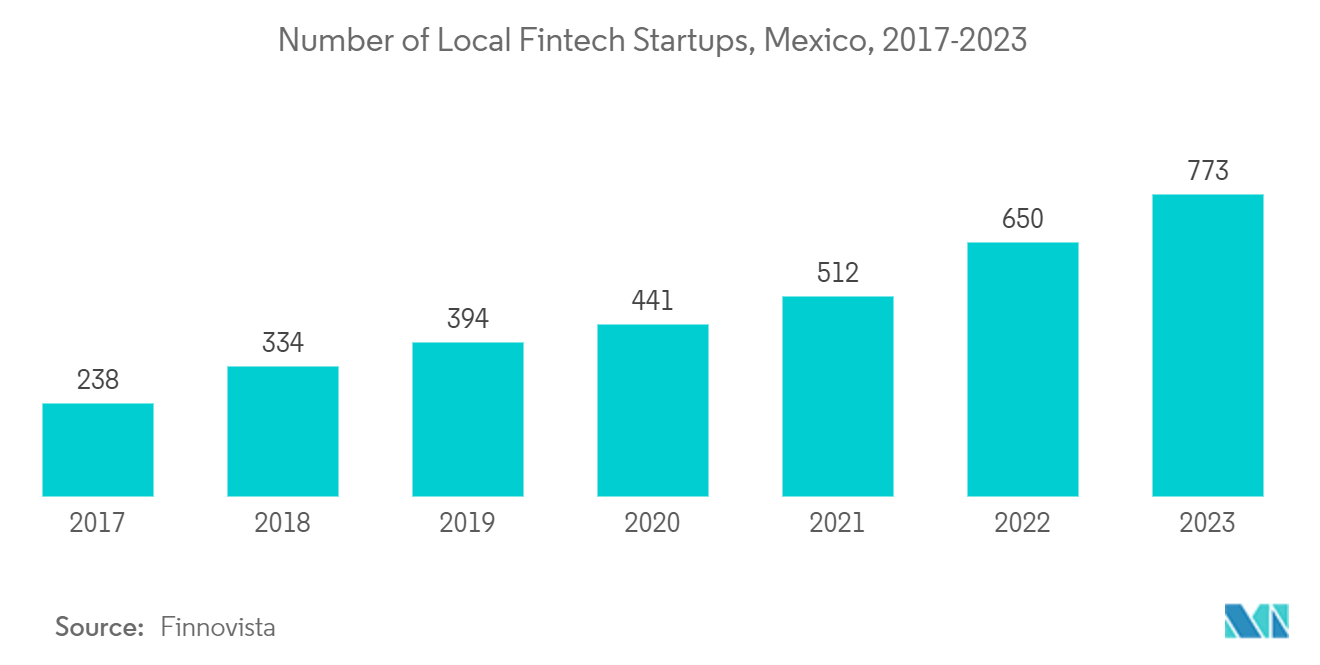
Competitive Landscape
The Mexico Digital Transformation market is semi consolidated, with a few prominent players such as Google LLC (Alphabet Inc.), IBM Corporation, Microsoft Corporation, Cisco Systems, Inc., Oracle Corporation and others; to increase market share, corporations continually spend on strategic partnerships or acquisitions and solution and services development. The following are some recent market developments:
- In June 2024, Amdocs, a software and services provider for communications and media firms, recently revealed that AT&T Mexico has successfully migrated its Amdocs Customer Experience Suite (CES) systems to Oracle Cloud Infrastructure (OCI). This strategic move positions AT&T Mexico to leverage enhanced flexibility, scalability, and cost-efficiency. The transition to OCI promises operational savings and equips AT&T Mexico with cutting-edge cloud infrastructure, empowering the company to further its distinctive market vision in Mexico, delivering top-tier services and customer experiences.
- In March 2024, Eviden, a key player in digital, cloud, big data, and security services, has unveiled its latest venture a Security Operations Center (SOC) in Monterrey, Mexico. This strategic move aims to bolster Eviden's cybersecurity offerings, catering specifically to organizations spanning North and South America. In Monterrey, Eviden's Mexico SOC is set to roll out its Managed Detection and Response (MDR) solutions. These solutions are designed to identify and neutralize threats and equip clients with proactive, data-driven responses. At the core of Eviden's MDR solution lies AIsaac Cyber Mesh, the company's cutting-edge artificial intelligence platform. This platform offers a complete suite of services, including threat intelligence, monitoring, incident analysis, and a robust response mechanism, all tailored to combat the evolving landscape of cyber threats.
Mexico Digital Transformation Industry Leaders
-
Google LLC (Alphabet Inc.)
-
IBM Corporation
-
Microsoft Corporation
-
Cisco Systems, Inc.
-
Oracle Corporation
- *Disclaimer: Major Players sorted in no particular order
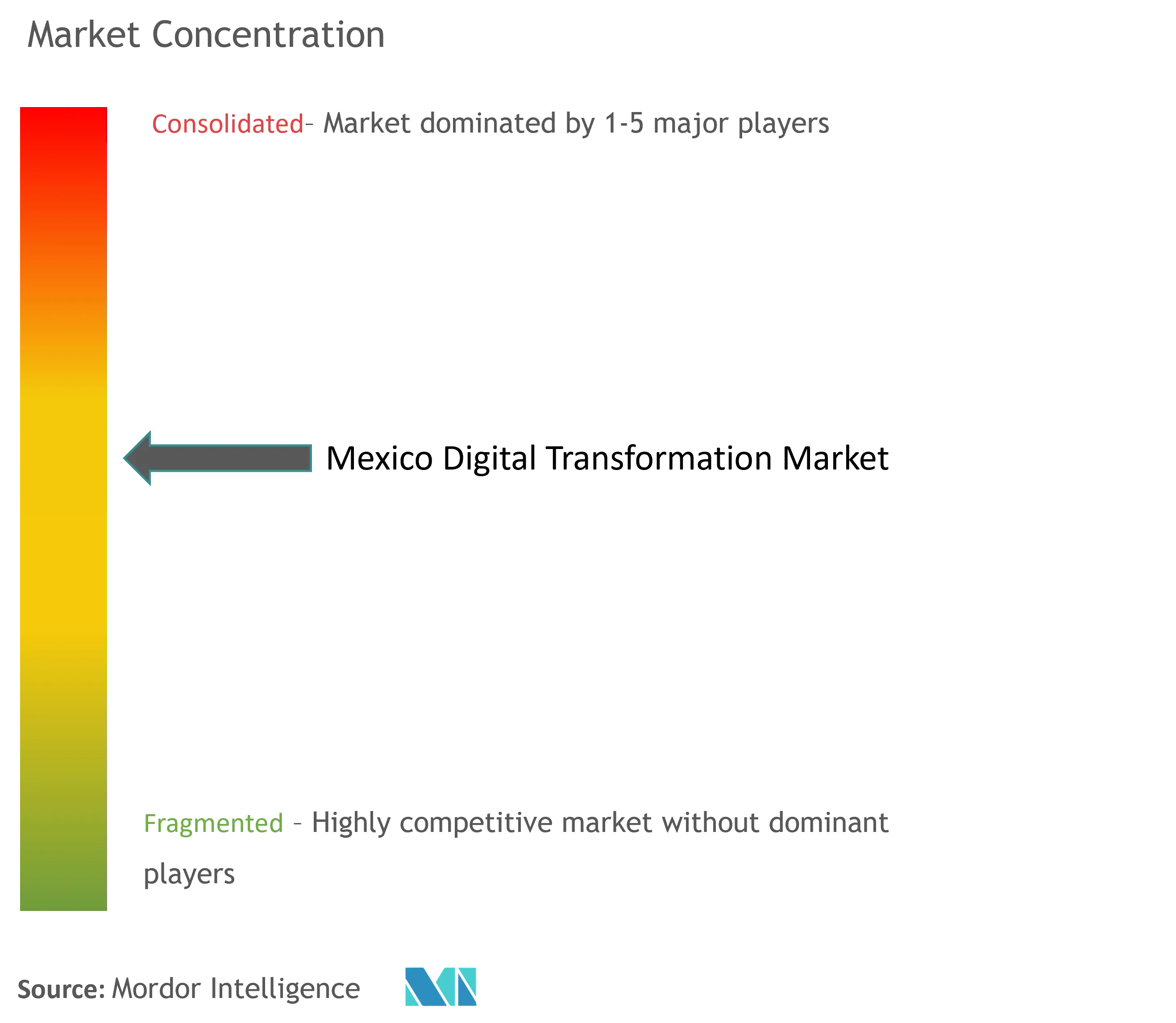
Recent Industry Developments
- July 2024: GlobalSign, a global certificate authority focusing on identity security, digital signatures, and IoT solutions, has unveiled its strategic foray into Mexico. This expansion comes through an enhanced collaboration with Seguridad America, primarily addressing the surging need for sophisticated cybersecurity offerings in Mexico. Seguridad America, operating from its new base in Mexico City, will now be the distributor for GlobalSign's comprehensive array of PKI-based products. With this, Mexican enterprises gain direct access to state-of-the-art solutions spanning certificate automation, digital signatures, IoT identity, and email security.
- May 2024: Microsoft, unveiled its inaugural data center region in Mexico, specifically in Queretaro. This strategic location aims to offer both local and international clients access to adaptable, robust, and reliable cloud services. Marking a significant milestone, Mexico emerges as Microsoft's premier data center region in Spanish-speaking Latin America, bolstering the tech giant's extensive network of over 60 cloud regions worldwide. This cutting-edge infrastructure empowers businesses, enabling swift adjustments to address escalating demands. It caters to Mexican enterprises seeking localized services and global firms eyeing Mexico as a catalyst for their digital evolution.
Mexico Digital Transformation Market Report Scope
Digital transformation involves leveraging digital technologies to overhaul traditional business processes and adapt them to changing market and customer demands. This revolutionizes business management, operations, and customer value delivery.
The Mexico digital transformation market is segmented by type and by end-user industry. By type the market is segmented into analytics, artificial intelligence and machine learning, extended reality (XR), Iot, industrial robotics, blockchain, additive manufacturing/3D printing, cybersecurity, cloud and edge computing, and other. By end user industry the market is segmented into manufacturing, oil, gas and utilities, retail &e-commerce, transportation and logistics, healthcare, BFSI, Telecom and IT, government and public sector, others. The Market Sizes and Forecasts are Provided in Terms of Value (USD) for all the Above Segments.
| Analytics, Artificial Intelligence and Machine Learning | Current Market Scenario and Market Projections for the Forecast Period |
| Key Growth Influencers (Drivers, Challenges, and Opportunities) | |
| Use Case Analysis | |
| Market Outlook | |
| Extended Reality (XR) | Current Market Scenario and Market Projections for the Forecast Period |
| Key Growth Influencers (Drivers, Challenges, and Opportunities) | |
| Use Case Analysis | |
| Market Outlook | |
| IoT | Current Market Scenario and Market Projections for the Forecast Period |
| Key Growth Influencers (Drivers, Challenges, and Opportunities) | |
| Use Case Analysis | |
| Market Outlook | |
| Industrial Robotics | Current Market Scenario and Market Projections for the Forecast Period |
| Key Growth Influencers (Drivers, Challenges, and Opportunities) | |
| Use Case Analysis | |
| Market Outlook | |
| Blockchain | Current Market Scenario and Market Projections for the Forecast Period |
| Key Growth Influencers (Drivers, Challenges, and Opportunities) | |
| Use Case Analysis | |
| Market Outlook | |
| Additive Manufacturing/3D Printing | Current Market Scenario and Market Projections for the Forecast Period |
| Key Growth Influencers (Drivers, Challenges, and Opportunities) | |
| Use Case Analysis | |
| Market Outlook | |
| Cyber security | Current Market Scenario and Market Projections for the Forecast Period |
| Key Growth Influencers (Drivers, Challenges, and Opportunities) | |
| Use Case Analysis | |
| Market Outlook | |
| Cloud and Edge Computing | Current Market Scenario and Market Projections for the Forecast Period |
| Key Growth Influencers (Drivers, Challenges, and Opportunities) | |
| Use Case Analysis | |
| Market Outlook | |
| Others | Current Market Scenario and Market Projections for the Forecast Period |
| Key Growth Influencers (Drivers, Challenges, and Opportunities) | |
| Use Case Analysis | |
| Market Outlook |
| Manufacturing |
| Oil, Gas and Utilities |
| Retail & e-commerce |
| Transportation and Logistics |
| Healthcare |
| BFSI |
| Telecom and IT |
| Government and Public Sector |
| Others |
| By Type | Analytics, Artificial Intelligence and Machine Learning | Current Market Scenario and Market Projections for the Forecast Period |
| Key Growth Influencers (Drivers, Challenges, and Opportunities) | ||
| Use Case Analysis | ||
| Market Outlook | ||
| Extended Reality (XR) | Current Market Scenario and Market Projections for the Forecast Period | |
| Key Growth Influencers (Drivers, Challenges, and Opportunities) | ||
| Use Case Analysis | ||
| Market Outlook | ||
| IoT | Current Market Scenario and Market Projections for the Forecast Period | |
| Key Growth Influencers (Drivers, Challenges, and Opportunities) | ||
| Use Case Analysis | ||
| Market Outlook | ||
| Industrial Robotics | Current Market Scenario and Market Projections for the Forecast Period | |
| Key Growth Influencers (Drivers, Challenges, and Opportunities) | ||
| Use Case Analysis | ||
| Market Outlook | ||
| Blockchain | Current Market Scenario and Market Projections for the Forecast Period | |
| Key Growth Influencers (Drivers, Challenges, and Opportunities) | ||
| Use Case Analysis | ||
| Market Outlook | ||
| Additive Manufacturing/3D Printing | Current Market Scenario and Market Projections for the Forecast Period | |
| Key Growth Influencers (Drivers, Challenges, and Opportunities) | ||
| Use Case Analysis | ||
| Market Outlook | ||
| Cyber security | Current Market Scenario and Market Projections for the Forecast Period | |
| Key Growth Influencers (Drivers, Challenges, and Opportunities) | ||
| Use Case Analysis | ||
| Market Outlook | ||
| Cloud and Edge Computing | Current Market Scenario and Market Projections for the Forecast Period | |
| Key Growth Influencers (Drivers, Challenges, and Opportunities) | ||
| Use Case Analysis | ||
| Market Outlook | ||
| Others | Current Market Scenario and Market Projections for the Forecast Period | |
| Key Growth Influencers (Drivers, Challenges, and Opportunities) | ||
| Use Case Analysis | ||
| Market Outlook | ||
| By End-User Industry | Manufacturing | |
| Oil, Gas and Utilities | ||
| Retail & e-commerce | ||
| Transportation and Logistics | ||
| Healthcare | ||
| BFSI | ||
| Telecom and IT | ||
| Government and Public Sector | ||
| Others | ||
Key Questions Answered in the Report
How big is the Mexico Digital Transformation Market?
The Mexico Digital Transformation Market size is expected to reach USD 39.98 billion in 2025 and grow at a CAGR of 17.18% to reach USD 88.33 billion by 2030.
What is the current Mexico Digital Transformation Market size?
In 2025, the Mexico Digital Transformation Market size is expected to reach USD 39.98 billion.
Who are the key players in Mexico Digital Transformation Market?
Google LLC (Alphabet Inc.), IBM Corporation, Microsoft Corporation, Cisco Systems, Inc. and Oracle Corporation are the major companies operating in the Mexico Digital Transformation Market.
What years does this Mexico Digital Transformation Market cover, and what was the market size in 2024?
In 2024, the Mexico Digital Transformation Market size was estimated at USD 33.11 billion. The report covers the Mexico Digital Transformation Market historical market size for years: 2019, 2020, 2021, 2022, 2023 and 2024. The report also forecasts the Mexico Digital Transformation Market size for years: 2025, 2026, 2027, 2028, 2029 and 2030.
Page last updated on:
Mexico Digital Transformation Market Report
Statistics for the 2025 Mexico Digital Transformation market share, size and revenue growth rate, created by Mordor Intelligence™ Industry Reports. Mexico Digital Transformation analysis includes a market forecast outlook for 2025 to 2030 and historical overview. Get a sample of this industry analysis as a free report PDF download.
